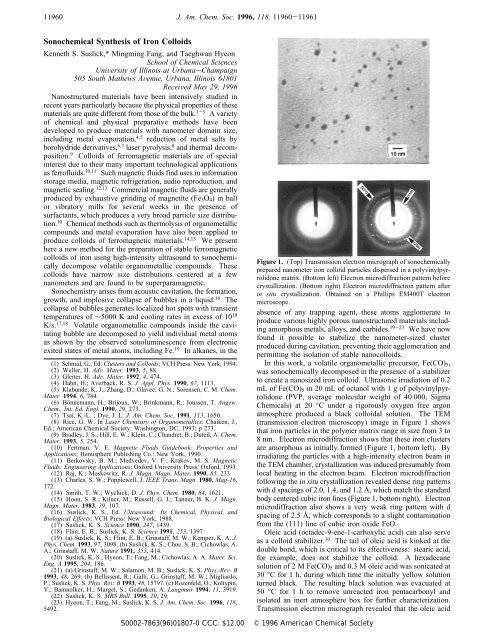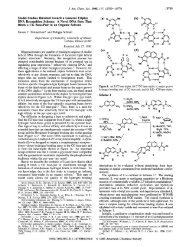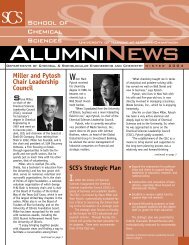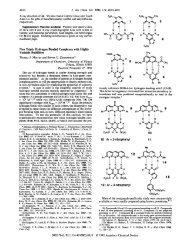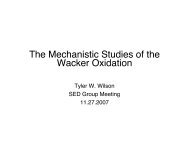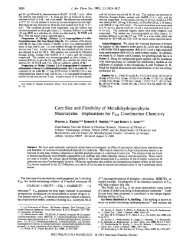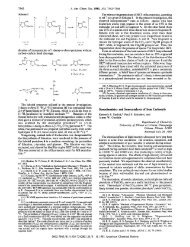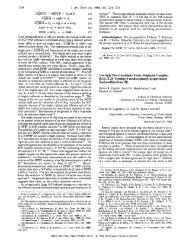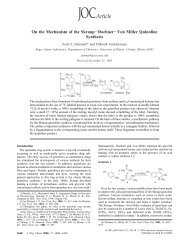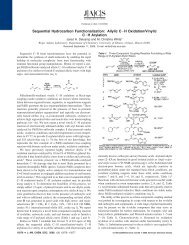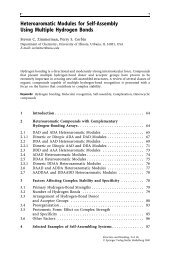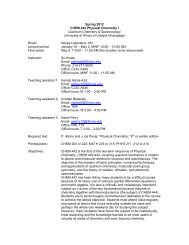J. Am. Chem. Soc., 1996, 118, 11960-11961. - School of Chemical ...
J. Am. Chem. Soc., 1996, 118, 11960-11961. - School of Chemical ...
J. Am. Chem. Soc., 1996, 118, 11960-11961. - School of Chemical ...
You also want an ePaper? Increase the reach of your titles
YUMPU automatically turns print PDFs into web optimized ePapers that Google loves.
<strong>11960</strong> J. <strong>Am</strong>. <strong>Chem</strong>. <strong>Soc</strong>. <strong>1996</strong>, <strong>118</strong>, <strong>11960</strong>-11961<br />
Sonochemical Synthesis <strong>of</strong> Iron Colloids<br />
Kenneth S. Suslick,* Mingming Fang, and Taeghwan Hyeon<br />
<strong>School</strong> <strong>of</strong> <strong>Chem</strong>ical Sciences<br />
UniVersity <strong>of</strong> Illinois at Urbana-Champaign<br />
505 South Mathews AVenue, Urbana, Illinois 61801<br />
ReceiVed May 29, <strong>1996</strong><br />
Nanostructured materials have been intensively studied in<br />
recent years particularly because the physical properties <strong>of</strong> these<br />
materials are quite different from those <strong>of</strong> the bulk. 1-3 A variety<br />
<strong>of</strong> chemical and physical preparative methods have been<br />
developed to produce materials with nanometer domain size,<br />
including metal evaporation, 4,5 reduction <strong>of</strong> metal salts by<br />
borohydride derivatives, 6,7 laser pyrolysis, 8 and thermal decomposition.<br />
9 Colloids <strong>of</strong> ferromagnetic materials are <strong>of</strong> special<br />
interest due to their many important technological applications<br />
as ferr<strong>of</strong>luids. 10,11 Such magnetic fluids find uses in information<br />
storage media, magnetic refrigeration, audio reproduction, and<br />
magnetic sealing. 12,13 Commercial magnetic fluids are generally<br />
produced by exhaustive grinding <strong>of</strong> magnetite (Fe 3 O 4 ) in ball<br />
or vibratory mills for several weeks in the presence <strong>of</strong><br />
surfactants, which produces a very broad particle size distribution.<br />
10 <strong>Chem</strong>ical methods such as thermolysis <strong>of</strong> organometallic<br />
compounds and metal evaporation have also been applied to<br />
produce colloids <strong>of</strong> ferromagnetic materials. 14,15 We present<br />
here a new method for the preparation <strong>of</strong> stable ferromagnetic<br />
colloids <strong>of</strong> iron using high-intensity ultrasound to sonochemically<br />
decompose volatile organometallic compounds. These<br />
colloids have narrow size distributions centered at a few<br />
nanometers and are found to be superparamagnetic.<br />
Sonochemistry arises from acoustic cavitation, the formation,<br />
growth, and implosive collapse <strong>of</strong> bubbles in a liquid. 16 The<br />
collapse <strong>of</strong> bubbles generates localized hot spots with transient<br />
temperatures <strong>of</strong> ∼5000 K and cooling rates in excess <strong>of</strong> 10 10<br />
K/s. 17,18 Volatile organometallic compounds inside the cavitating<br />
bubble are decomposed to yield individual metal atoms<br />
as shown by the observed sonoluminescence from electronic<br />
exited states <strong>of</strong> metal atoms, including Fe. 19 In alkanes, in the<br />
(1) Schmid, G., Ed. Clusters and Colloids; VCH Press: New York, 1994.<br />
(2) Weller, H. AdV. Mater. 1993, 5, 88.<br />
(3) Gleiter, H. AdV. Mater. 1992, 4, 474.<br />
(4) Hahn, H.; Averback, R. S. J. Appl. Phys. 1990, 67, 1113.<br />
(5) Klabunde, K. J.; Zhang, D.; Glavee, G. N.; Sorensen, C. M. <strong>Chem</strong>.<br />
Mater. 1994, 6, 784.<br />
(6) Bönnemann, H.; Brijoux, W.; Brinkmann, R.; Joussen, T. Angew.<br />
<strong>Chem</strong>., Int. Ed. Engl. 1990, 29, 273.<br />
(7) Tsai, K.-L. ; Dye, J. L. J. <strong>Am</strong>. <strong>Chem</strong>. <strong>Soc</strong>. 1991, 113, 1650.<br />
(8) Rice, G. W. In Laser <strong>Chem</strong>istry <strong>of</strong> Organometallics; Chaiken, J.,<br />
Ed.; <strong>Am</strong>erican <strong>Chem</strong>ical <strong>Soc</strong>iety: Washington, DC, 1993; p 273.<br />
(9) Bradley, J. S.; Hill, E. W.; Klein, C.; Chaudret, B.; Duteil, A. <strong>Chem</strong>.<br />
Mater. 1993, 5, 254.<br />
(10) Fertman, V. E. Magnetic Fluids Guidebook: Properties and<br />
Applications; Hemisphere Publishing Co.: New York, 1990.<br />
(11) Berkovsky, B. M.; Medvedev, V. F.; Krakov, M. S. Magnetic<br />
Fluids: Engineering Applications; Oxford University Press: Oxford, 1993.<br />
(12) Raj, K.; Moskowitz, R. J. Magn. Magn. Mater. 1990, 85, 233.<br />
(13) Charles, S. W.; Popplewell, J. IEEE Trans. Magn. 1980, Mag-16,<br />
172.<br />
(14) Smith, T. W.; Wychick, D. J. Phys. <strong>Chem</strong>. 1980, 84, 1621.<br />
(15) Hoon, S. R.; Kilner, M.; Russell, G. J.; Tanner, B. K. J. Magn.<br />
Magn. Mater. 1983, 39, 107.<br />
(16) Suslick, K. S., Ed. Ultrasound: Its <strong>Chem</strong>ical, Physical, and<br />
Biological Effects; VCH Press: New York, 1988.<br />
(17) Suslick, K. S. Science 1990, 247, 1439.<br />
(18) Flint, E. B.; Suslick, K. S. Science 1991, 253, 1397<br />
(19) (a) Suslick, K. S.; Flint, E. B.; Grinstaff, M. W.; Kemper, K. A. J.<br />
Phys. <strong>Chem</strong>. 1993, 97, 3098. (b) Suslick, K. S.; Choe, S. B.; Cichowlas, A.<br />
A.; Grinstaff, M. W. Nature 1991, 353, 414.<br />
(20) Suslick, K. S.; Hyeon, T.; Fang, M.; Cichowlas, A. A. Mater. Sci.<br />
Eng. A 1995, 204, 186.<br />
(21) (a) Grinstaff, M. W.; Salamon, M. B.; Suslick, K. S. Phys. ReV. B<br />
1993, 48, 269. (b) Bellissent, R.; Galli, G.; Grinstaff, M. W.; Migliardo,<br />
P.; Suslick, K. S. Phys. ReV.B1993, 48, 15797. (c) Rozenfeld, O.; Koltypin,<br />
Y.; Bamnolker, H.; Margel, S.; Gedanken, A. Langmuir 1994, 11, 3919.<br />
(22) Suslick, K. S. MRS Bull. 1995, 20, 29.<br />
(23) Hyeon, T.; Fang, M.; Suslick, K. S. J. <strong>Am</strong>. <strong>Chem</strong>. <strong>Soc</strong>. <strong>1996</strong>, <strong>118</strong>,<br />
5492.<br />
S0002-7863(96)01807-0 CCC: $12.00<br />
Figure 1. (Top) Transmission electron micrograph <strong>of</strong> sonochemically<br />
prepared nanometer iron colloid particles dispersed in a polyvinylpyrrolidone<br />
matrix. (Bottom left) Electron microdiffraction pattern before<br />
crystallization. (Bottom right) Electron microdiffraction pattern after<br />
in situ crystallization. Obtained on a Phillips EM400T electron<br />
microscope.<br />
absence <strong>of</strong> any trapping agent, these atoms agglomerate to<br />
produce various highly porous nanostructured materials including<br />
amorphous metals, alloys, and carbides. 19-23 We have now<br />
found it possible to stabilize the nanometer-sized cluster<br />
produced during cavitation, preventing their agglomeration and<br />
permitting the isolation <strong>of</strong> stable nanocolloids.<br />
In this work, a volatile organometallic precursor, Fe(CO) 5 ,<br />
was sonochemically decomposed in the presence <strong>of</strong> a stabilizer<br />
to create a nanosized iron colloid. Ultrasonic irradiation <strong>of</strong> 0.2<br />
mL <strong>of</strong> Fe(CO) 5 in 20 mL <strong>of</strong> octanol with 1g<strong>of</strong>polyvinylpyrrolidone<br />
(PVP, average molecular weight <strong>of</strong> 40 000, Sigma<br />
<strong>Chem</strong>icals) at 20 °C under a rigorously oxygen free argon<br />
atmosphere produced a black colloidal solution. The TEM<br />
(transmission electron microscopy) image in Figure 1 shows<br />
that iron particles in the polymer matrix range in size from 3 to<br />
8 nm. Electron microdiffraction shows that these iron clusters<br />
are amorphous as initially formed (Figure 1, bottom left). By<br />
irradiating the particles with a high-intensity electron beam in<br />
the TEM chamber, crystallization was induced presumably from<br />
local heating in the electron beam. Electron microdiffraction<br />
following the in situ crystallization revealed dense ring patterns<br />
with d spacings <strong>of</strong> 2.0, 1.4, and 1.2 Å, which match the standard<br />
body centered cubic iron lines (Figure 1, bottom right). Electron<br />
microdiffraction also shows a very weak ring pattern with d<br />
spacing <strong>of</strong> 2.5 Å, which corresponds to a slight contamination<br />
from the (111) line <strong>of</strong> cubic iron oxide FeO.<br />
Oleic acid (octadec-9-ene-1-carboxylic acid) can also serve<br />
as a colloid stabilizer. 10 The tail <strong>of</strong> oleic acid is kinked at the<br />
double bond, which is critical to its effectiveness: stearic acid,<br />
for example, does not stabilize the colloid. A hexadecane<br />
solution <strong>of</strong> 2 M Fe(CO) 5 and 0.3 M oleic acid was sonicated at<br />
30 °C for 1 h, during which time the initially yellow solution<br />
turned black. The resulting black solution was evacuated at<br />
50 °C for1htoremove unreacted iron pentacarbonyl and<br />
isolated an inert atmosphere box for further characterization.<br />
Transmission electron micrograph revealed that the oleic acid<br />
© <strong>1996</strong> <strong>Am</strong>erican <strong>Chem</strong>ical <strong>Soc</strong>iety
Communications to the Editor J. <strong>Am</strong>. <strong>Chem</strong>. <strong>Soc</strong>., Vol. <strong>118</strong>, No. 47, <strong>1996</strong> 11961<br />
Figure 3. Magnetization hysteresis loops for the nanometer iron<br />
particles dispersed in a PVP matrix at 250 K: (+) magnetization data<br />
points; (9) demagnetization points. No hysteresis is observed and<br />
consequently the magnetization data points are overlapped by the<br />
demagnetization data.<br />
Figure 2. Transmission electron micrograph <strong>of</strong> sonochemically<br />
prepared iron colloid particles (with average particle size <strong>of</strong> 8 nm)<br />
stabilized by oleic acid.<br />
colloid particles were slightly larger than the PVP colloid but<br />
much more uniform, with average particle size <strong>of</strong> 8 nm (Figure<br />
2). The electron microdiffraction after in situ crystallization<br />
showed that oleic acid particles are a mixture <strong>of</strong> Fe and FeO.<br />
When the particles <strong>of</strong> ferro- or ferrimagnetic materials are<br />
smaller than the dimensions <strong>of</strong> a single domain (which for Fe<br />
and Co is ≈20 nm), thermal fluctuations will supersede the<br />
Weiss anisotropy above the blocking temperature. Such<br />
particles are called superparamagnetic. 24 An operational definition<br />
<strong>of</strong> a superparamagnetism has two requirements. First, the<br />
plot <strong>of</strong> magnetization (M) vs applied magnetic field (H) must<br />
show no hysteresis. Second, the magnetization <strong>of</strong> an isotropic<br />
sample at different temperatures must superimpose when plotted<br />
against H/T, after correction for the temperature dependence <strong>of</strong><br />
the spontaneous magnetization. Sonochemically synthesized<br />
nanosized iron particles show no hysteresis in their magnetization<br />
data at 290 K (Figure 3). 25 Furthermore plots <strong>of</strong> magnetization<br />
vs (magnetic field)/(temperature) for the Fe/PVP sample<br />
at 290, 250, and 200 K (Figure 4) superimpose after correction<br />
for the temperature dependence <strong>of</strong> the spontaneous magnetization.<br />
Thus, sonochemically prepared nanometer Fe colloids are<br />
superparamagnetic.<br />
High saturation magnetization is desirable for magnetic fluid<br />
application and is highly sensitive to the method <strong>of</strong> preparation.<br />
The saturated magnetization (M s ) <strong>of</strong> the initially prepared PVP<br />
colloidal nanometer Fe particles is a respectable 101 emu/g (Fe)<br />
at 290 K. M s is determined by extrapolating the experimental<br />
plot <strong>of</strong> M vs 1/H using data at high magnetic fields. Standard<br />
crystalline bcc Fe has a saturated magnetization <strong>of</strong> 222 emu/g<br />
(Fe) at 298 K, 26 whereas bulk amorphous Fe saturates at 156<br />
(24) Jacobs, I. S.; Bean, C. P. In Magnetism III; Rado, G. T., Suhl, H.,<br />
Eds.; Academic Press: New York, 1963; pp 271-351.<br />
(25) Magnetic studies were conducted with a Quantum Design MPMS,<br />
7 T, SQUID magnetometer. Colloidal iron samples were loaded into gelatin<br />
capsules inside an inert atmosphere box, carried to the magnetometer under<br />
inert atmosphere, and rapidly transferred to the sample chamber. All<br />
magnetic data have been corrected for the diamagnetism <strong>of</strong> the gelatin<br />
capsules, solvents, and colloid stabilizers.<br />
(26) Cullity, B. D. Introduction to Magnetic Materials; Addison-Wiley:<br />
New York, 1972; pp 171-190.<br />
Figure 4. Magnetization (M) versus magnetic field/temperature (H/<br />
T) at(9) 200 K, (+) 250 K, and (]) 290 K, after correcting for the<br />
temperature dependence <strong>of</strong> spontaneous magnetization (I s/I o) for the<br />
nanometer iron colloid particles dispersed in a polyvinylpyrrolidone<br />
matrix.<br />
emu/g (Fe). 21 The saturation magnetization <strong>of</strong> our sonochemically<br />
prepared iron colloid is greater than that <strong>of</strong> solvated<br />
nanometer-scale iron particles produced by metal vapor deposition<br />
(55 emu/g (Fe) at 55 kOe) 27 or ion-exchange resin stabilized<br />
nanocrystalline γ-Fe 2 O 3 (99 emu/g at 10 kOe), 28 but smaller<br />
than those <strong>of</strong> copoly(styrene-butadiene)-stabilized iron colloids<br />
(120-170 emu/g (Fe) at 10 kOe). 14 For a comparison, the<br />
saturation magnetization <strong>of</strong> a commercial magnetite-based<br />
magnetic fluid is 123 emu/g (Fe). 29<br />
In conclusion, a simple synthetic method has been discovered<br />
to produce nanosized iron colloid using high-intensity ultrasound.<br />
Nanometer iron particles dispersed in polyvinylpyrrolidone<br />
(PVP) matrix or stabilized by adsorption <strong>of</strong> oleic acid have<br />
been synthesized by sonochemical decomposition <strong>of</strong> Fe(CO) 5 .<br />
Transmission electron micrographs show that the iron particles<br />
have a relatively narrow range in size from 3 to 8 nm for<br />
polyvinylpyrrolidone, while oleic acid gives an even more<br />
uniform distribution at 8 nm. Magnetic measurements revealed<br />
that these nanometer iron particles are superparamagnetic with<br />
a saturation magnetization <strong>of</strong> 101 emu/g (Fe) at 290 K. This<br />
work is easily extended to colloids <strong>of</strong> other metals and to alloys<br />
<strong>of</strong> two or more metals, simply by using multiple volatile<br />
precursors. For example, we have recently made nanostructured<br />
Fe/Co alloys sonochemically. 20 Controlled reaction with O 2 or<br />
other oxidants will also permit the formation <strong>of</strong> transition metal<br />
oxide colloids.<br />
Acknowledgment. We gratefully acknowledge Pr<strong>of</strong>essor Myron<br />
B. Salamon for many helpful discussions. This work was supported<br />
by the NSF (DMR-8920538 and CHE-9420758). For electron microscopy,<br />
we thank the assistance <strong>of</strong> the UIUC Center for Microanalysis<br />
<strong>of</strong> Materials. supported by the DOE.<br />
JA961807N<br />
(27) Kernizan, C. F.; Klabunde, K. J.; Sorensen, C. M.; Hadjipanayis,<br />
G. C. <strong>Chem</strong>. Mater. 1990, 2, 70.<br />
(28) Ziolo, R. F.; Giannelis, E. P.; Weinstein, B. A.; O’Horo, M. P.;<br />
Ganguly, B. N.; Mehrotra, V.; Russell, M. W.; Huffman, D. R. Science<br />
1992, 257, 219.<br />
(29) Ferr<strong>of</strong>luids Corporation, catalog no. APG 047. Magnetite (Fe 3O 4)<br />
is dispersed in hydrocarbon with an aromatic amine as stabilizer (12.3 wt<br />
% <strong>of</strong> Fe).


